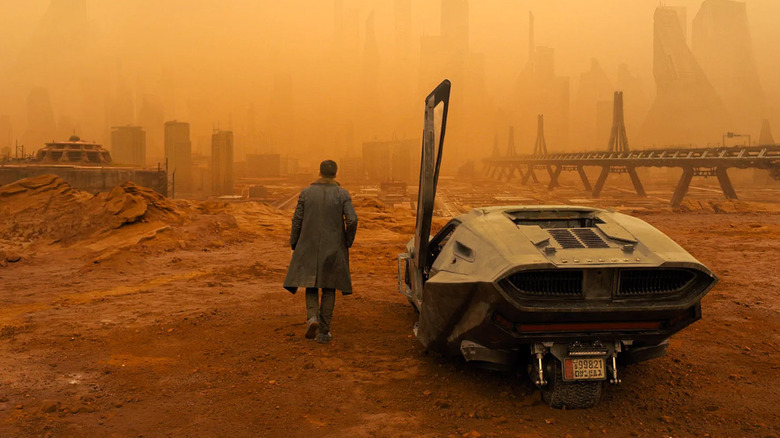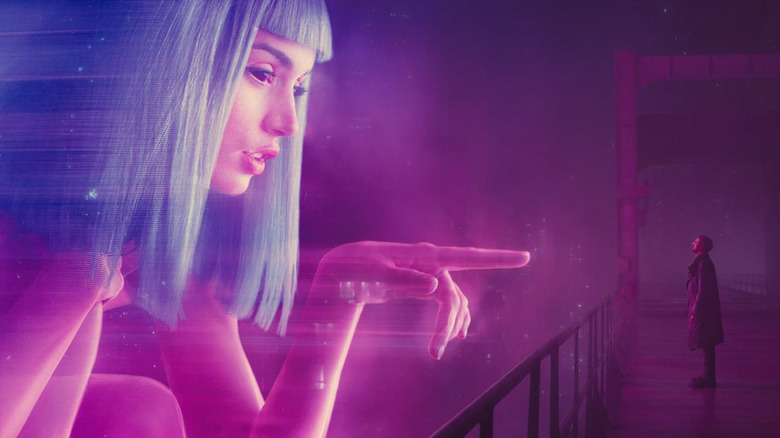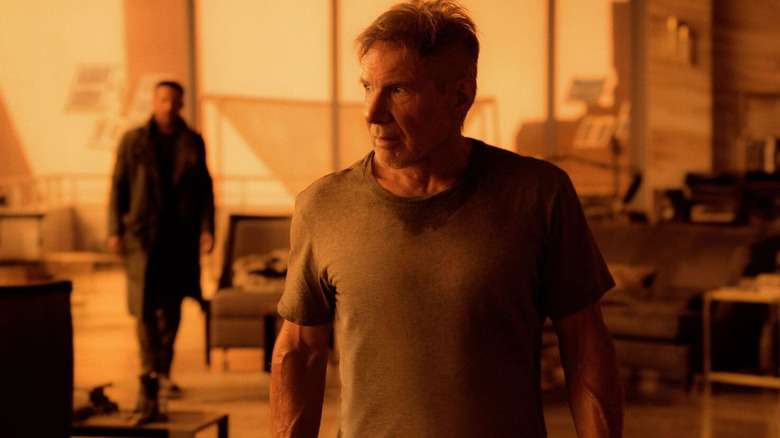Even Blade Runner 2049's Simplest Scenes Required Some VFX Wizardry
It's no secret that "Blade Runner 2049" is a VFX masterclass. Denis Villeneuve's long-awaited sequel to the 1982 sci-fi classic "Blade Runner" showcases exactly what can be accomplished by filmmakers with a keen eye and a good visual effects team. The film's VFX even won big at the Academy Awards.
As well as picking up Best Cinematography for Roger Deakins, the film also won Best Visual Effects for the work of John Nelson, Gerd Nefzer, Paul Lambert, and Richard R. Hoover. It's no surprise, of course, "Blade Runner 2049" includes some of the most visually striking effects work in modern cinema, especially those beautiful scenes of a holographic Joi billboard, and the appearance of a digitally de-aged Rachael (Sean Young).
The world of "Blade Runner 2049" is an obvious stage for visual effects. Set in a near-future Los Angeles, the film's neo-noir setting makes for some striking visuals, brought to life by the award-winning team. Flying cars, futuristic weapons, and gritty urban cityscapes provide plenty of opportunities for a stunning variety of visual effects work. A ménage à trois with a sci-fi twist gave the film one of its most striking scenes — but there was a lot more visual effects work that went unnoticed.
"The nature of our work was not to have spectacle for spectacle's sake," said VFX supervisor John Nelson. "But rather tone it down to make the visuals fit well into director Denis Villeneuve's vision."
In fact, the VFX work in "Blade Runner 2049" is so good, that you won't even know it's happening.
I've seen things you people wouldn't believe
There's certainly plenty of spectacle in "Blade Runner 2049" and that's largely down to the visual effects team; however, when it comes to the jaw-dropping return of Rachael in the film's final act, director Denis Villeneuve didn't want people to be wowed by the VFX. He didn't want them to notice it at all.
"I want my mother to say, 'Oh, you found someone who looks really like her!' I didn't want people to think it's a synthetic performance."
I've often said that the best visual effects are the ones we don't notice, when the VFX team has labored over shots to integrate their work into existing scenery, blending the artificial with the real. Villeneuve seems to agree, especially when it comes to his digitally de-aged replicant. I have to admit — the return of Rachael was astounding.
"For me it's mesmerizing. You see her coming, and Deckard's looking at her, and I want myself to believe. We did it. We worked on it until we felt that she looks real, that I was emotionally involved like the other characters."
Sure, we've seen de-aged characters before, in the likes of "Tron: Legacy" and "Rogue One." The big problem lies in how believable they are ... and "Blade Runner 2049" certainly cracked that one. "It [takes] very long to do," said Villeneuve. "That's the thing that maybe saved my ass — is that I limited the amount of shots." The de-aged Rachael was actually a composite of a real-life stand-in actress, along with a younger version of Sean Young created entirely with digital effects. The result is a replicant of the original replicant that looks and feels real.
But the effects work on "Blade Runner 2049" gets even more subtle than that...
You look like a good Joe
One of the most visually striking scenes in "Blade Runner 2049" is when K encounters the holographic billboard advertising Joi – the very same holographic A.I. he has installed at home. It's a neon-drenched dream and now-iconic shot. It also made use of some impressive visual effects work to pull it off, and it was a lot more real than you might realize. Basically, the shot was filmed in two separate sittings, with Joi (Ana de Armas) and K (Ryan Gosling) filming the scene entirely separately.
"We call it the Pink Joi scene," said VFX supervisor, John Nelson. "We shot in the first couple of days of photography. We shot Ana in pink makeup and not much else, on greenscreen, looking at a Coke bottle sized cut-out of K."
Essentially, they used body tracking to map Ana de Armas onto a CG version of Joi, then created a load of projection, interior, and back-shape effects to get the desired look. A bit of pixelation would complete the digital projection ... and then this footage was used for a bit of cool camera trickery.
"Later, we shot K. Roger filmed this on a set which had a 24 or 30-foot-tall video wall, like a screen you get for rock concerts and that served as the interactive lighting. ... Roger put the footage we shot of Joi, of Ana, on that video wall. Of course, she's flat. Then he completely misted up the whole stage, so the stage got really atmospheric and filled with mist. ... it lit up the atmosphere in a really nice way."
The pink mist became a signature for that neon-style shot, and with a blend of VFX and crafty cinematography, you can see why the movie picked up those Oscars.
We're all just looking out for something real
Here's one you won't expect: "Blade Runner 2049" used VFX in the scene where K meets Deckard. The scene sees our new replicant pal confront Deckard, the iconic "Blade Runner" who was thought long dead but has actually been hiding out in the ruins of Las Vegas. The scene itself was a simple one, but there was a problem:
"Outside in the plates they had a physical backing where there was a printed image of the Las Vegas skyline," explained Adrien Saint Gyrons of Framestore. "But that led to some wrinkles in the backing and there were some issues with depth."
Essentially, the printed image, acting like an old school matte painting, was unusable, and this meant it had to be digitally replaced in post.
"We had to modify the backing in all of the shots and that meant a crazy amount of roto. The compositors spent the time balancing each shot to get that virtual backing to sit in it."
Additionally, those scenes required a lot more work due to the lighting. The signature radioactive orange haze is intensely atmospheric ... but was also increasingly problematic for the film's visual effects team.
"It's designed to remove all blue light so when you're trying to describe surfaces in that light you've got only two thirds of the spectrum to work with," said Richard Hoover. "Roger hand-made that filter specially to give the proper look he desired. I said, 'Let's render everything in white light and if it looks right to us then we'll apply the filter and that's what we get.'"
The result is a hazy ghost-town where the bright lights of Las Vegas used to shine.
All these shots will be lost in time...
Much like the original "Blade Runner," the rain plays an important part in building the atmosphere. During a scene in which K's Spinner is shot down by scavengers, the rain on his car's windows is instrumental in creating the oppressive, ravaged world around them. However, making these weather effects wasn't exactly easy.
"Traditionally with rain you do your foreground, midground, background and you don't think about it," said visual effects supervisor, Paul Lambert. "On this one, rain took the longest to render because of the amount of light everywhere. We were forever having to tweak the size and how much rain. It just takes for the rain to be slightly off to completely break the scale and we were breaking the scale all of the time."
The sheer number of raindrops included in wider shots was incredible. "We had a lot of versions that had completely maxed out on the particle count and it still didn't look big enough," said visual effects artist Chris McLaughlin. But it was all worth it in the end. Some of the film's most impressive, climactic scenes take place in the rain, calling back that iconic speech by original "Blade Runner" star Rutger Hauer:
"All these moments will be lost in time, like tears in rain."
It's more than just a nod to the original film, though. The result is a living, breathing world full of intricate details that you might barely even notice. It's this attention to detail that places "Blade Runner 2049" within a real, tangible world. One that's set in a far future, but a world that we still recognize — and these little details keep the film grounded.


